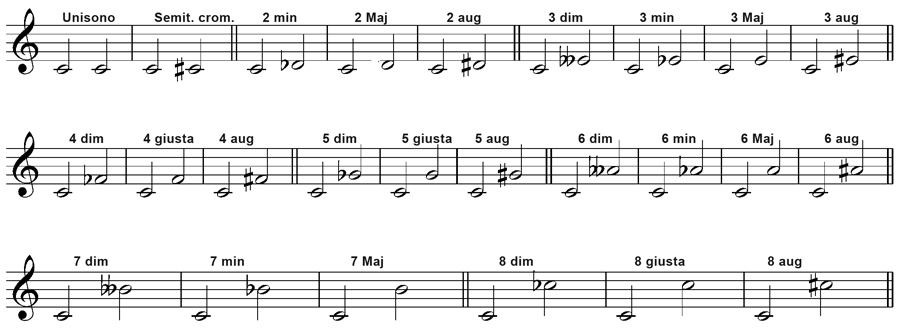Second lesson - intervals |
"In the first lesson we defined the Major scale as a sequence of 8 notes, each separated by these distances: This allows us to define the double nature of the intervals: |
 |
Now, in order to build a Theoretic system of notes This is more pertinent to "musical grammar" than it is to harmonic theory, but it'll be best to define this topic before beginning its discussion. And to do just that we will begin from C, naming all the intervals that this sound can form meeting the other 11 of the chromatic scale, ascending or descending. |
 |
These are all the intervals that a C can determine |
||||
| C | C | Unisono | Root | |
| C | C# | Semitono cromatico | ||
| C | Db | 2 min | 2 | |
| C | D | 2 Maj | ||
| C | D# | 2 aug | ||
| C | Ebb | 3 dim | 3 | |
| C | Eb | 3 min | ||
| C | E | 3 Maj | ||
| C | E# | 3 aug | ||
| C | Fb | 4 dim |
4 | |
| C | F | 4 giusta | ||
| C | F# | 4aug | ||
| C | Gb | 5 dim | 5 | |
| C | G | 5 giusta | ||
| C | G# | 5 aug | ||
| C | Abb | 6 dim | 6 | |
| C | Ab | 6 min | ||
| C | A | 6 maj | ||
| C | A# | 6 aug | ||
| C | Bbb | 7 dim | 7 | |
| C | Bb | 7 min | ||
| C | B | 7 Maj | ||
| C | Cb | 8 dim | 8 | |
| C | C | 8 giusta | ||
| C | C# | 8 aug | ||
| C | la tonica, da il nome alla scala |
| D | è la 2 Maj (maggiore) di C |
| E | è la 3 Maj di C |
| F | è la 4 giusta di C |
| G | è la 5 giusta di C |
| A | 6 Maj di C |
| B | 7 Maj di C |
At this point, musical theory distinguishes the intervals in consonant and dissonant. The unison, the octave, perfect 5, 3rd and 6th. (both Major and Minor), are defined consonant intervals. |
 |
To exhaust this parenthesis - purely grammatical but necessary – it is important to note what happens when these intervals are reversed, that is to say when the one below goes above and vice versa. |
 |
The second interval is the reverse of the first |
So, in summary, how do we determine that the harmonic interval E – C (for example) is a Minor 6th.? |
And to end this"grammatical" and rather boring lesson, the Maestro assigned me about fifty intervals to be correctly denominated. And going from grammar to philosophy, we departed from each other, deciding that the next lesson will take place in three weeks. |
| next |